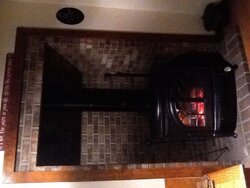Hello all, newbie here.
After seeing other posts, I know you all will want the following before I even pose a question! You are all sticklers for detail which I can appreciate.
Kalamazoo, Michigan (cold, 115" of snowfall this year!)
1965 built ranch, 2200 sq. ft., walkout basement, well-built, very air tight
2 traditional fireplaces (no real heat value!), yet we burn 4 cord a year
Propane heated home
Replacing roof and adding 10" of blow-in next week
Family of four tired of paying propane prices...
Question, I've had two competing fireplace experts come out. Both very well known in the area. One is pushing the Large Flush Hybrid by fireplacextrodinair (Cat), the other a 33 Elite by fireplacextrodinair (non-cat).
I like the added efficiency of the cat, but scared of the costs/warranty/undue added attention and or work/I hear cats need be replaced and attended to an awful lot. We like simple, the cost diff is minimal. Is it true that I'll be replacing/cleaning the cat every few years or so? Is it worth the added efficiency (5% according to the marketing)?
The brand isn't so important as is your thoughts - cat or non cat.
Other particulars, if it helps....
I'm in my 40s, healthy, wood is not an issue (we're on 15 acres wooded).
We are "green", but not so much that the cat's EPA #s sways us.
Have many (8 or so) seasoned and unseasoned cords of hickory, walnut and oak on hand.
We wish to burn 24/7 going forward.
The cat option is 3 cu ft, non-cat is 2.2 (advantage cat).
Looking forward to your sage advice...
After seeing other posts, I know you all will want the following before I even pose a question! You are all sticklers for detail which I can appreciate.
Kalamazoo, Michigan (cold, 115" of snowfall this year!)
1965 built ranch, 2200 sq. ft., walkout basement, well-built, very air tight
2 traditional fireplaces (no real heat value!), yet we burn 4 cord a year
Propane heated home
Replacing roof and adding 10" of blow-in next week
Family of four tired of paying propane prices...
Question, I've had two competing fireplace experts come out. Both very well known in the area. One is pushing the Large Flush Hybrid by fireplacextrodinair (Cat), the other a 33 Elite by fireplacextrodinair (non-cat).
I like the added efficiency of the cat, but scared of the costs/warranty/undue added attention and or work/I hear cats need be replaced and attended to an awful lot. We like simple, the cost diff is minimal. Is it true that I'll be replacing/cleaning the cat every few years or so? Is it worth the added efficiency (5% according to the marketing)?
The brand isn't so important as is your thoughts - cat or non cat.
Other particulars, if it helps....
I'm in my 40s, healthy, wood is not an issue (we're on 15 acres wooded).
We are "green", but not so much that the cat's EPA #s sways us.
Have many (8 or so) seasoned and unseasoned cords of hickory, walnut and oak on hand.
We wish to burn 24/7 going forward.
The cat option is 3 cu ft, non-cat is 2.2 (advantage cat).
Looking forward to your sage advice...
Last edited:


 .
.